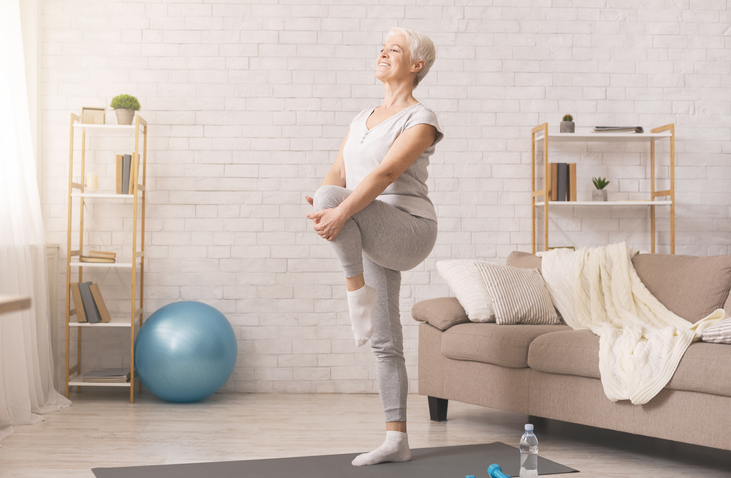By Nancy Alexander, PT, CSCS
In this community, we tend to focus on how important it is to exercise our bodies. Physical activity helps improve our mobility, level of fitness and our overall health. Movement reduces the odds of developing heart disease, stroke, and diabetes. You can – with exercise – lose weight, lower your blood pressure, prevent depression, or just look better. The benefits seem endless. But what about combining physical exercise with activities that benefit your mind? Enhancing your results for both is indeed possible.
Challenging your mind with activities is typically known as cognitive training. Integrating cognitive exercises with physical activity — often called dual-task training or combined cognitive-physical training — has shown promise in enhancing brain health and physical function, particularly in older adults. We’ve even started doing this in our Living Well Academy classes to rave reviews. This approach aims to leverage the benefits of both types of exercises to promote overall well-being and potentially mitigate age-related cognitive decline.
Physical activity alone is beneficial to the brain. Exercise changes the brain in ways that protect memory and thinking skills, according to Harvard Health. In a study done at the University of British Columbia, researchers found that regular aerobic exercise, the kind that gets your heart and your sweat glands pumping, appears to boost the size of the hippocampus, the brain area involved in verbal memory and learning. As I said in my book, Get UP! Defy Aging with Movement, “What is good for your heart is good for your brain.”
Cognitive exercises alone are also beneficial to the brain. Exercising your mind is crucial for maintaining cognitive health and well-being throughout life. It can improve memory, focus, and overall cognitive function, while also helping to reduce stress and anxiety. Regular mental exercise, like learning new things or challenging yourself with puzzles, can promote brain plasticity, helping your brain adapt and stay sharp.
Brain plasticity (also called neuroplasticity) is important and is defined as the brain’s ability to change its organization and function necessary for normal development of the nervous system and makes it possible to adapt to changing demands. Examples of situations where your brain demonstrates neuroplasticity include learning a new language, practicing music, or memorizing how to navigate around your city. (Study.com)
Your brain’s plasticity becomes important when:
- Learning new skills: Practicing a new activity, such as playing an instrument or learning a language, can stimulate the growth of new neural connections.
- Recovering from brain injury: After a stroke or other brain damage, the brain can use plasticity to reroute neural signals around the injured area.
- Adapting to environmental changes: The brain can adjust to changes in its environment, such as moving to a new country or experiencing a major life event.
- Aging: Plasticity continues throughout life, although it may decline with age.
Research shows us that physical and cognitive activities alone are beneficial for your brain. But can the results be enhanced by combining them? There is evidence this is true.
According to a systemic review documented by the National Institutes of Health, authors questioned whether combined training might produce additive effects when the group comparisons are equated in terms of exercise intensity and modality. The results were positive. “Performing cognitive and physical exercise simultaneously, and interactive training (e.g., exergames, square stepping) produced the largest gains in executive functions, speed, and global cognition, as well as the largest improvements in physical functions.” (NIH)

How can we combine brain and physical exercises? Here are some ways:
- Dual-tasking during cardiovascular exercise: While walking, running, hiking, cycling, or swimming, try:
- Counting backward by threes from 100.
- Reciting a favorite poem or story.
- Memorizing a list of words or items needed for a party.
- Solving simple math problems mentally.
- Combine balance/coordination with mental challenges:
- Stand on one foot while reciting the alphabet backward or spelling words aloud.
- Perform lunges or squats while saying the months of the year in reverse order.
- March in place while reciting states in the US that have a coastline.
Combining tasks can help you in the following ways said Sue Paul, Senior Director of Well-Being and Brain Health at Asbury Communities:
- Synergistic Benefits: Research suggests that combining cognitive and physical training might lead to greater improvements than either type of training performed in isolation.
- Neuroplasticity: Physical exercise increases blood flow and neurotrophic factors (like Brain-Derived Neurotrophic Factor) in the brain, fostering neurogenesis (growth of new brain cells) and synaptic plasticity (strengthening connections between neurons). Cognitive exercises, on the other hand, guide these new brain cells into functional neural networks, thus solidifying the gains from physical activity.
- Improved cognitive functions because combining the two can enhance:
- Memory: Remembering new choreography steps or lists of words while exercising can challenge the brain’s recall abilities.
- Attention and Focus: Dual-tasking requires focused attention and can improve the ability to switch between tasks and maintain concentration.
- Executive Functions: This includes skills like planning, problem-solving, and decision-making, which are activated when tackling a puzzle during a workout or strategizing in a game like pickleball.
It is important to exercise your body and your mind. Both strategies alone are worthy as you age. Combine the two and you might find the results lead to a more fulfilling and meaningful life. If you try some of these exercises and your performance is not what you expected, show yourself some grace and keep at it. Continue to practice them and change the tasks from time to time to keep it fresh. Just like performing a sport or any other activity, consistency matters. Set a schedule and follow it. Keep moving and challenge yourself to improve your body and your mind.
Sources:
“Get UP! Defy Aging with Movement,” by Nancy Alexander. https://www.prosolutions55.com/books/
Harvard Health: https://www.health.harvard.edu/blog/regular-exercise-changes-brain-improve-memory-thinking-skills-201404097110
National Institutes of Health: https://pubmed.ncbi.nlm.nih.gov/35399365/#:~:text=Results%20showed%20that%20combined%20training,three%2Dlevel%20meta%2Danalysis

Leave a Reply